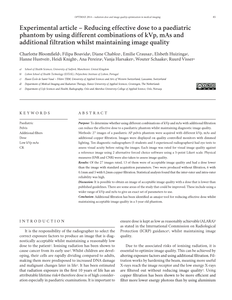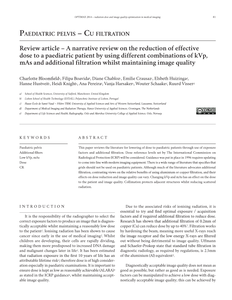Arsenic contamination of groundwater is a major public health concern worldwide. The problem has been reported mainly in southern Asia and, especially, in Bangladesh. Slow-sand filters (SSF) augmented with iron were proven to be a simple, low-cost and decentralized technique for the treatment of arsenic-contaminated sources. In this research, three pilot-scale SSF (flowrate 6 L·h−1) were tested regarding their capability of removing arsenic from groundwater in conditions similar to those found in countries like Bangladesh (70 µg As(III) L−1, 26 °C). From the three, two filters were prepared with mixed media, i.e., sand mixed with corrosive iron matter (CIM filter) and iron-coated sand (ICS filter), and a third conventional SSF was used as a reference. The results obtained showed that the CIM filter could remove arsenic below the World Health Organization (WHO) guideline concentration of 10 µg·L−1, even for inlet concentrations above 150 µg·L−1. After 230 days of continuous operation the arsenic concentration in the effluent started increasing, indicating depletion or saturation of the CIM layer. The effluent arsenic concentration, however, never exceeded the Bangladeshi standard of 50 µg·L−1 throughout the whole duration of the experiments.
DOCUMENT

Algorithmic curation is a helpful solution for the massive amount of content on the web. The term is used to describe how platforms automate the recommendation of content to users. News outlets, social networks and search engines widely use recommendation systems. Such automation has led to worries about selective exposure and its side effects. Echo chambers occur when we are over-exposed to the news we like or agree with, distorting our perception of reality (1). Filter bubbles arise where the information we dislike or disagree with is automatically filtered out – narrowing what we know (2). While the idea of Filter Bubbles makes logical sense, the magnitude of the "filter bubble effect", reducing diversity, has been questioned [3]. Most empirical studies indicate that algorithmic recommendations have not locked large audience segments into bubbles [4]. However, little attention has been paid to the interplay between technological, social, and cognitive filters. We proposed an Agent-based Modelling to simulate users' emergent behaviour and track their opinions when getting news from news outlets and social networks. The model aims to understand under which circumstances algorithmic filtering and social network dynamics affect users' innate opinions and which interventions can mitigate the effect. Agent-based models simulate the behaviour of multiple individual agents forming a larger society. The behaviour of the individual agents can be elementary, yet the population's behaviour can be much more than the sum of its parts. We have designed different scenarios to analyse the contributing factors to the emergence of filter bubbles. It includes different recommendation algorithms and social network dynamics. Cognitive filters are based on the Triple Filter Bubble model [5].References1.Richard Fletcher, 20202.Eli Pariser, 20123.Chitra & Musco, 20204. Möller et al., 20185. Daniel Geschke et al, 2018
DOCUMENT

Nog problematischer is het semantische informatiefilter, waarbij de door een auteur gebruikte (verhullende) taal het (on)mogelijk maakt te achterhalen of de verstrekte informatie ‘waar’ of ‘niet waar’ is. Of, misschien beter, ‘betrouwbaar’ of ‘niet betrouwbaar’. Semantische filters ontwaren (en ontwarren) is moeilijk.
DOCUMENT

Purpose: To determine whether using different combinations of kVp and mAs with additional filtration can reduce the effective dose to a paediatric phantom whilst maintaining diagnostic image quality.Methods: 27 images of a paediatric AP pelvis phantom were acquired with different kVp, mAs and additional copper filtration. Images were displayed on quality controlled monitors with dimmed lighting. Ten diagnostic radiographers (5 students and 5 experienced radiographers) had eye tests to assess visual acuity before rating the images. Each image was rated for visual image quality against a reference image using 2 alternative forced choice software using a 5-point Likert scale. Physical measures (SNR and CNR) were also taken to assess image quality.Results: Of the 27 images rated, 13 of them were of acceptable image quality and had a dose lower than the image with standard acquisition parameters. Two were produced without filtration, 6 with 0.1mm and 5 with 0.2mm copper filtration. Statistical analysis found that the inter-rater and intra-raterreliability was high.Discussion: It is possible to obtain an image of acceptable image quality with a dose that is lower than published guidelines. There are some areas of the study that could be improved. These include using a wider range of kVp and mAs to give an exact set of parameters to use.Conclusion: Additional filtration has been identified as amajor tool for reducing effective dose whilst maintaining acceptable image quality in a 5 year old phantom.
DOCUMENT

This paper reviews the literature for lowering of dose to paediatric patients through use of exposure factors and additional filtration. Dose reference levels set by The International Commission on Radiological Protection (ICRP) will be considered. Guidance was put in place in 1996 requires updatingto come into line with modern imaging equipment. There is a wide range of literature that specifies that grids should not be used on paediatric patients. Although much of the literature advocates additional filtration, contrasting views on the relative benefits of using aluminium or copper filtration, and theireffects on dose reduction and image quality can vary. Changing kVp and mAs has an effect on the dose to the patient and image quality. Collimation protects adjacent structures whilst reducing scattered radiation.
DOCUMENT

In sports, inertial measurement units are often used to measure the orientation of human body segments. A Madgwick (MW) filter can be used to obtain accurate inertial measurement unit (IMU) orientation estimates. This filter combines two different orientation estimates by applying a correction of the (1) gyroscope-based estimate in the direction of the (2) earth frame-based estimate. However, in sports situations that are characterized by relatively large linear accelerations and/or close magnetic sources, such as wheelchair sports, obtaining accurate IMU orientation estimates is challenging. In these situations, applying the MW filter in the regular way, i.e., with the same magnitude of correction at all time frames, may lead to estimation errors. Therefore, in this study, the MW filter was extended with machine learning to distinguish instances in which a small correction magnitude is beneficial from instances in which a large correction magnitude is beneficial, to eventually arrive at accurate body segment orientations in IMU-challenging sports situations. A machine learning algorithm was trained to make this distinction based on raw IMU data. Experiments on wheelchair sports were performed to assess the validity of the extended MW filter, and to compare the extended MW filter with the original MW filter based on comparisons with a motion capture-based reference system. Results indicate that the extended MW filter performs better than the original MW filter in assessing instantaneous trunk inclination (7.6 vs. 11.7◦ root-mean-squared error, RMSE), especially during the dynamic, IMU-challenging situations with moving athlete and wheelchair. Improvements of up to 45% RMSE were obtained for the extended MW filter compared with the original MW filter. To conclude, the machine learning-based extended MW filter has an acceptable accuracy and performs better than the original MW filter for the assessment of body segment orientation in IMU-challenging sports situations.
DOCUMENT

Sinds 2010 produceert NieuWater ultrapuur water uit effluent van de RWZI Emmen. Dit water wordt als proceswater geleverd aan de NAM in Schoonebeek. De biologische actieve koolfiltratie met zuurstofdosering (BODAC), die als voorzuivering gebruikt wordt, lijkt ook een veelbelovende techniek om geneesmiddelen te verwijderen.
DOCUMENT

The Smart Current Limiter is a switching DC to DC converter that provides a digitally pre-set input current control for inrush limiting and power management. Being able to digitally adjust the current level in combination with external feedback can be used for control systems like temperature control in high power DC appliances. Traditionally inrush current limiting is done using a passive resistance whose resistance changes depending on the current level. Bypassing this inrush limiting resister with a Mosfet improves efficiency and controllability, but footprint and losses remain large. A switched current mode controlled inrush limiter can limit inrush currents and even control the amount of current passing to the application. This enables power management and inrush current limitation in a single device. To reduce footprint and costs a balance between losses and cost-price on one side and electromagnetic interference on the other side is sought and an optimum switching frequency is chosen. To reduce cost and copper usage, switching happens on a high frequency of 300kHz. This increases the switching losses but greatly reduces the inductor size and cost compared to switching supplies running on lower frequencies. Additional filter circuits like snubbers are necessary to keep the control signals and therefore the output current stable.
DOCUMENT

This online STS muhabbet, friendly but critically engaging conversation that took place between Yetiskin and Lovink will walk you through the stages of identifying the problems, threats, and possibilities that media technologies have brought to the table of not only users but also social science researchers who are mostly outside the current modes of technical knowledge production. It is a frank discussion on the biases of codes and algorithms upon which social media platforms have been built, the lack of technological awareness in academia, and the effect of this lack in terms of centralizing governance structures. Yetiskin and Lovink not only elaborate on the embeddedness of the political, economic and cultural in the technical but also the embeddedness of technical means in the way that we think and express ourselves. They also discuss the ways of politicizing the contemporary technologies, making them the matter of concern for both the users and the social scientists, and opening the black boxes of them i.e. making visible the invisible: media infrastructures, biased filters, the firewalls against the democratization of technologies. Enjoy your STS muhabbet!
MULTIFILE

Existing methods for risk assessment for medical aids are being surpassed by the rapid rise and availability of apps, serious games and online e-health applications. There is a lack of transparency for end users (consumers, patients, care professionals and consultants, and health insurers) regarding the status, operation and effectiveness of these new tools. At the same time, existing filters for risk assessment of medical aids often lead to excessively strict validation requirements for these new tools, which inhibits their possible contribution to better and more affordable care for the patient. It also erects barriers to new entrepreneurial entrants to the care market and their innovative ideas. This all requires an improved system of risk analysis and validation of e-health applications. A vital condition for an improved system is the introduction of the shortest possible assessment period for this form of quality care, considering the tempo of technological developments in both technical platforms and the applications that run on them (critical time-to-market), so that products do not lose their value before they are released to the market.
DOCUMENT
